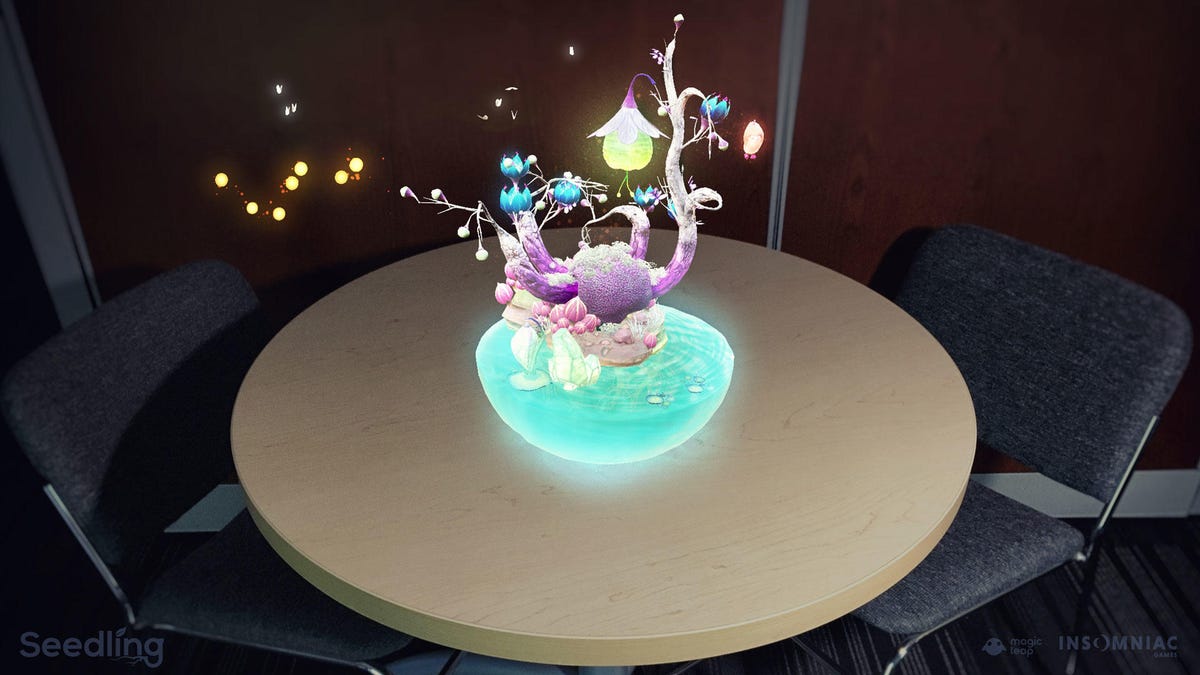Magic Leap's Seedling showed me the challenges of AR gardening
Living with virtual plants in the real world is a game of subtleties.

This comes pretty close to what it looks like to use Seedling in AR.
I'm putting in my contact lenses at our office lunch table, booting up a little clip-on belt pack, placing goggles delicately over my face, and turning on a wireless controller. It's a lot of steps, but it's because I have to water my virtual plant. It's 5 p.m. and I almost forgot.
Magic Leap's first mixed-reality headset, the Magic Leap One, is a dev kit that isn't exactly intended for everyday people. Nevertheless, Insomniac Games has released a game for Magic Leap, called Seedling, that's now available, provided you have a $2,295 Magic Leap One headset. Magic Leap's debut hardware arrived in August, but the company's not had a ton of apps for the headset yet. Seedling, announced at Magic Leap's first developer conference in October, is one of just a few apps so far, besides Sigur Ros' Tonandi and Rovio's AR version of Angry Birds.
I got to play the game on Magic Leap One hardware that Magic Leap sent to my office, so I could live with the experience for a few days. I don't own a Magic Leap One, and it's been months since I used one. I don't own a HoloLens. I've used lot of VR, and I use augmented reality on phones. But AR headsets are a different type of experience that most people haven't tried. And Seedling shows a little taste of what makes AR different from VR.
Seedling is a surprisingly small-scale experience. And like most augmented-reality apps, it's layered right onto your own world. Seedling starts by scanning my immediate environment, which requires a flat surface, ideally a raised table. I stand in my office's cafeteria, at a pool table. A briefcase materializes on the table: It's a field kit for my research mission. I'm meant to be growing an alien plant. A seed drops down and blossoms into a beautiful little tree.
My job after that is to prune the seedling and care for it. The Magic Leap One controller can dial up several tools: a tweezer, a watering can, trimming clippers. I can twist the floating tools and approach the plant. I start moving around it, like I'm tending a ghost bonsai. The plant stays somewhat stable on the pool table, jittering a bit from imperfect object placement. I can only get so close before the plant vanishes: Magic Leap's projected holographic effects need to be at least a foot or so from my headset's tracking cameras.
The seedling is meant to stay in my environment as I care for it over days, in real time. Today, my first day, I water it and feel the watering can's water trickle via haptic rumbling via the controller. I snip a few branches. I pluck floating yellow energy balls out of the air, listening a voice's instructions, and feed them to the seedling's alien frond-tentacle as it eats. The plant grows a few leaves and buds. Am I done for the day? My watering can is out of water now. I take off the headset, remove my contact lenses. See you tomorrow, seedling.
I haven't gotten mine to flower yet.
The next day, I put in new contact lenses, put the headset back on. The room needs to be rescanned, and the tree placed back on the table. It's grown a bit more. I water it. I see a little pig-nosed alien fly in, casting an air-trail of pixie dust. It seems to sniff the plant and leave.
It will probably take days more for the whole story, which I think involves alien biological research, to unfold. According to Insomniac Games' Nathaniel Bell, who also worked on Insomniac's VR games Edge of Nowhere and The Unspoken, Seedling is a project that could lead to deeper game ideas down the road, and even perhaps move to mobile platforms such as AR-ready phones. It's a game that's really an experiment, designed as much to explore how intimate interfaces and environments can work with AR headsets.
It's also an exercise in minimalism. That one ghostly plant on the table is the entire experience, and it's purposely designed not to be too massive, because Magic Leap's field of view is limited. By staying small, most of it fits in the limited rectangle of the viewing area in front of my face.
No one around me seems to understand what I'm doing as I care for the plant. When I'm done, I take off the headset and realize I've been lurking around an empty table. It doesn't feel like VR to me... it's more like a small immersive theater performance, casting an imaginary spotlight on a corner of my world.
Would this all be just as possible on a phone? Maybe. It's a hassle to get the Magic Leap set up, and after 20 minutes or so, I feel like I need a break. And, the Magic Leap's visual experience isn't seamless. But it's also a more personal experience with the headset on. As AR apps and new AR headsets continue to emerge, maybe Seedling is the beginning of thinking about how small-scale games can work. It's not as powerful as the best VR, but it's a tiny bit more intimate.
And tomorrow, I feel like I want to check back in and see how my seedling's doing.
CNET's Holiday Gift Guide: The place to find the best tech gifts for 2018.
VR's missing link: You likely haven't bought a VR headset yet and it's beginning to show.

